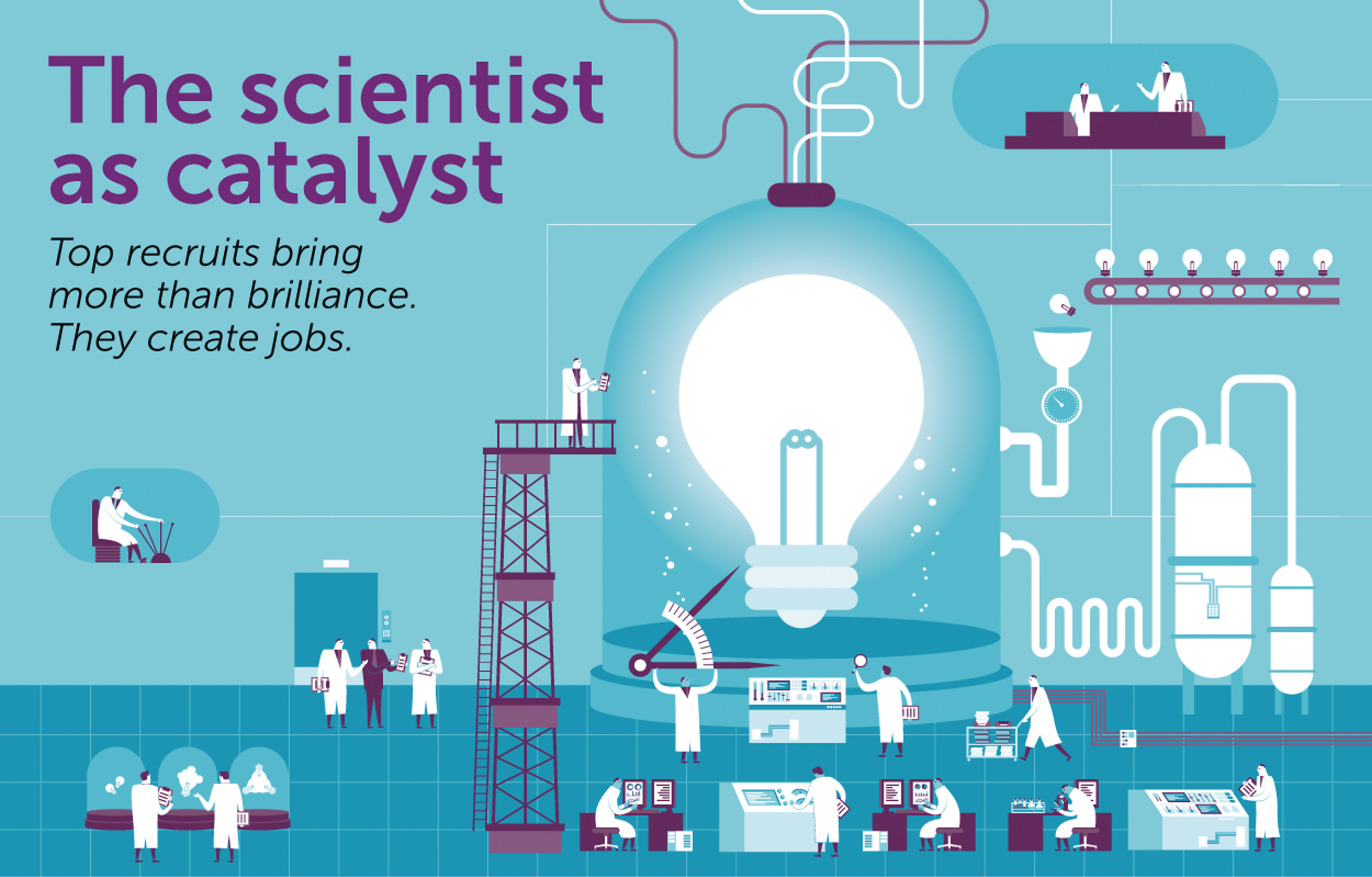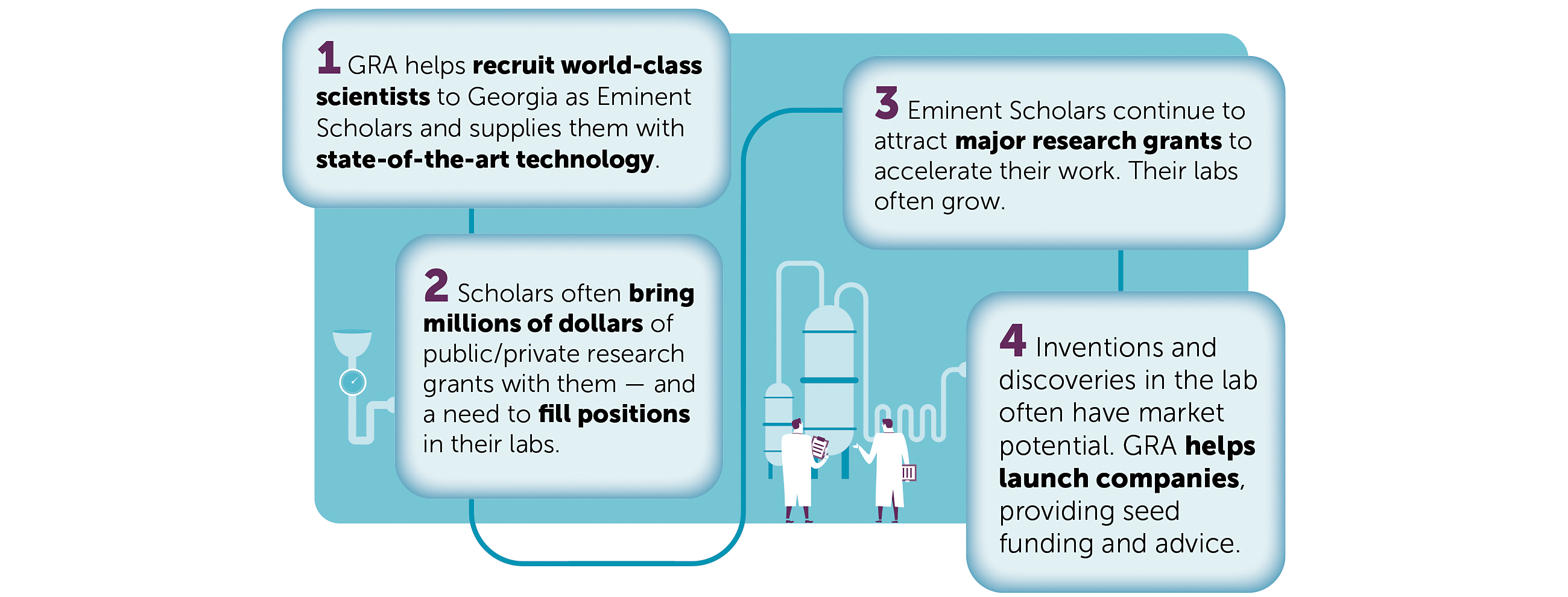

When a university lands a top scientist, the effect is far greater – it ignites an engine capable of generating power for a long time.
To understand how this works, consider Ted Ross.
A renowned expert in infectious disease, Ross came to the University of Georgia to build a new vaccine research center. The year was 2015, and he was contemplating his next move after directing a sophisticated viral immunity research program at the Vaccine and Gene Therapy Institute of Florida.
The institute was phasing out, but Ross’s work wasn’t. When he agreed to relocate to Georgia, Ross was in the midst of a 7-year, $10.4 million research effort to design, develop and test novel vaccine candidates to battle influenza, Zika, HIV/AIDS and other viral diseases.
So, he brought those funds with him to UGA, as well as a need to hire a team of research professionals. It’s as if a small and promising business had relocated overnight.

Today, that “business” — UGA’s Center for Vaccines and Immunology, or CVI — employs 65 people and has a research program totaling $18 million. The work of the center has the confidence of major federal funding partners, as well as Sanofi Pasteur, the vaccine division of the multinational pharma Sanofi.
As of 2019, GRA’s $5.75 million investment in CVI had helped generate a return of $26 million in Federal R&D grants and contracts. As much as $130 million could still come through a single multi-year grant from NIH, announced in October 2019.
“Bringing world-class scientists to Georgia as GRA Eminent Scholars carries all kinds of benefits,” says Russell Allen, GRA’s president and CEO. “They typically arrive with a funded program and an impressive network of contacts in industry, research and philanthropy. And their new lab brings instant job creation.”
Statistics support this. The brain trust of scientists that GRA helps universities recruit as Eminent Scholars are a small portion of the research workforce, but they bring in enormous amounts of outside funding. While the 72 Scholars and their teams account for 5 percent of all scientists in Georgia’s labs, they make up 25 percent of all research funding. In 2018, the Scholars’ labs alone employed over 1,300 people.
Gabrielle Kirton’s job was one of the positions that opened up as UGA’s CVI began to grow. The research professional and UGA grad had been laid off from a drug development program at Alexion Pharmaceuticals, so she decided to look into lab openings at her alma mater.

In January, she joined the lab of Dr. Karen Norris, another GRA Eminent Scholar inside CVI and a former colleague of Ross's at the University of Pittsburgh. “Most of what I do is to purify proteins for vaccines studies,” Kirton explains. “Our team focuses on vaccines for people whose immune systems are compromised. These are people who die from things that should not make them sick.”
David Lee is another UGA alumnus employed at CVI. The research technician runs blood tests on inoculated people to help shape vaccine exploration. “I wanted to get experience with a good research lab before starting medical school,” Lee says, adding that working in a research lab somewhere was his “number one priority.”
Ross’s longtime collaboration with Sanofi Pasteur factors mightily into hiring people like Kirton and Lee – and in making progress toward developing a vaccine that covers many types of influenza, one of CVI’s major goals.
It’s a partnership that pre-dates Ross’s Florida days: He first teamed up with the company in 2012, while at the University of Pittsburgh, to develop a platform called COBRA that might someday protect people from all strains of flu. Today, he and his team are preparing to bring potential vaccines into human clinical trials after seeing success in animal models.

Instrumental in these efforts is James Allen, one of Ross’s Florida colleagues who followed Ross to Athens and who now serves as project lead for COBRA.
“I was open to working anywhere in the country,” says Allen, who leads the center’s flagship project, an effort to develop a universal flu vaccine. “But we’re doing some groundbreaking things here. The way flu vaccines are made hasn’t changed since 1940. Using modern technology, we’re working to bring medical practices up to the 21st century.”
GRA funded key pieces of that technology, an investment that can make or break the recruitment of scientists like Ross and Norris. Having state-of-the-art instruments gives scientists a competitive edge when applying for multimillion-dollar research grants. The commitment from GRA and UGA to renovate 15,000 square feet of the university’s 40-year-old Veterinary Teaching Hospital helped too, and future renovations will accommodate CVI’s growth.
While a universal flu vaccine has been a focal point of CVI’s work, the center has a bigger and broader vision – namely, expand understanding of how to protect all people from infectious disease. “We want to know more about why people and animals react differently to vaccine formulations so that we can construct vaccines that work well in as many people and animals as possible,” Ross says.

Thus, the aim is to grow the Center from its current six labs to as many as 12, totaling 100 faculty and staff. Key to this expansion is a unit that allows scientists to evaluate all aspects of vaccine testing in animals and human clinical trials – so that the science translates to the bedside.
“There’s a gap between when you finish a proof of concept and when you begin testing it in the clinic,” Ross says, “and to bridge that gap, you need partners that have the resources to move the work forward. We’re fortunate to have those partners.”